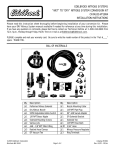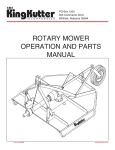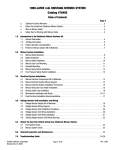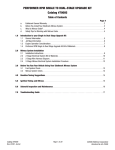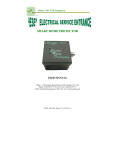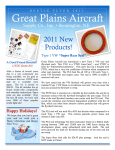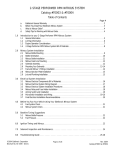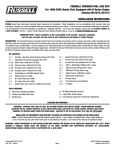Download Edelbrock 71883 Automobile Parts User Manual
Transcript
EDELBROCK NITROUS SYSTEMS “DRY” TO “WET” NITROUS SYSTEM CONVERSION KIT CATALOG #71883 INSTALLATION INSTRUCTIONS Please read this instruction sheet thoroughly before beginning installation of your conversion kit. Please have your DRY Nitrous System manual available if needed for reference at any time during this installation. If you have any questions or comments, please feel free to contact our Technical Hotline at: 1-800-416-8628 from 7a.m.-5p.m., Monday through Friday, Pacific Time or e-mail us at [email protected]. BILL OF MATERIALS Qty. ❑1 ❑1 ❑2 ❑1 ❑4 ❑5 ©2005 Edelbrock Corporation Brochure #63-0399 Description Performer Fuel Solenoid E1 Nitrous Nozzle 4AN to 1/8”NPT Fuel Fitting 3AN to 1/8”NPT Fuel Fitting Solenoid Mounting Screws Various Jets Page 1 of 4 Qty. ❑1 ❑1 ❑1 ❑2 ❑1 Description Nozzle Mounting Collar 3AN 90° 15” Blue Line 3AN 90° 15” Red Line Solenoid Bracket 4AN Red 18” Line Catalog #71883 Rev. 05/05 INSTALLATION INSTRUCTIONS This concludes the removal and disassembly of the dry nitrous system. From this point on, we will be installing components for the wet nitrous system. This includes using both the new components that are supplied with this kit, as well as re-using certain components that were supplied with your dry nitrous system such as one of the nitrous solenoids and the dry nitrous system wiring harness. WARNING!!! Before performing any of these steps, turn off the bottle valve and purge the nitrous system of pressure. Failure to do so may cause engine damage and/or personal injury. DRY COMPONENTS REMOVAL 1. Remove the 3AN nitrous line currently installed leading from the second nitrous solenoid to the dry nitrous nozzle. 2. Remove the dry nitrous nozzle and installed jet from the nozzle collar. Leave the nozzle collar in place for the time being. Later on during the installation, we will determine if the dry nozzles mounting location will be suitable for the E1 nozzle mounting location or if this will have to be re-located. 3. Disconnect the 4AN feed line from the nitrous solenoids. Leave the line in place since this line will be used for the wet system as well. 4. Disconnect the positive solenoid wires from the blue wire coming from the relay wiring harness. 5. Disconnect the ground wire from the first solenoid. Make sure that you do not damage the ring terminal because this ground will be re-used when the solenoid is re-installed. 6. Disconnect the ground wire from the second solenoid leading to the fuel pressure safety switch. 7. Remove the fuel pressure safety switch. 8. Using Teflon Paste, install one of the supplied red 4AN to 1/8”NPT fittings into the port where the fuel pressure safety switch used to be mounted. 9. Disconnect the vacuum lines that were installed for the dry nitrous system installation and return the vacuum routing to the fuel pressure regulator back to the factory configuration. 10. Remove the nitrous solenoid assembly from the engine compartment. 11. Disassemble the nitrous solenoid assembly carefully. You will be re-using one of the nitrous solenoids for your wet nitrous system installation so take care not to damage the wiring or solenoid body upon disassembly. You will also re-use the blue 4AN to 1/8”NPT INLET fitting and the blue 3AN to 1/8”NPT OUTLET fitting, so be careful not to damage the thread on these fittings when disassembling. ©2005 Edelbrock Corporation Brochure #63-0399 WET COMPONENTS INSTALLATION 1. Using Teflon Paste, install the supplied red 3AN to 1/8”NPT fitting into the OUTLET of the Performer Fuel Solenoid. 2. Using Teflon Paste, install the remaining red 4AN to 1/8”NPT fitting supplied with this kit into the INLET of the Performer Fuel Solenoid. 3. Mount one of the new solenoid brackets supplied in this kit to the bottom of the Performer Fuel Solenoid using two of the supplied solenoid mounting screws. 4. Select which Performer Nitrous Solenoid you are going to re-use. Using Teflon Paste, install the blue 4AN to 1/8”NPT fitting into the INLET side of the Performer Nitrous Solenoid. 5. Using Teflon Paste, install the blue 3AN to 1/8”NPT fitting into the OUTLET side of the Performer Nitrous Solenoid. 6. Mount the remaining supplied solenoid bracket to the bottom of the Performer Nitrous Solenoid using the remaining two solenoid mounting screws. 7. Remove the intake boot to allow easy access to the nozzle collar. 8. Verify the location of the nozzle collar. Make sure that it is in a location where it has a fairly straight, unobstructed shot into the manifolds plenum. Also, make sure that the nozzle is located AFTER the MAF sensor in the intake boot, if equipped. If the dry nozzle collar is located in a good place, remove the dry nozzle, dry nozzle collar and nut, and replace with the supplied E1 nozzle mounting collar and nut. You will need to enlarge the mounting hole in the intake boot to allow the E2 collar to reach through the intake boot. If the dry nozzle collar is located in a bad location, such as before the MAF sensor, in the airbox, or far upstream in the boot, use a 1/16” plug to fill the hole and drill a new hole for the location of the E1 nozzle collar and nut. Page 2 of 4 Catalog #71883 Rev. 05/05 - DC/mc 9. Using Teflon Paste, install the E1 nozzle into the nozzle collar in the intake boot. Be sure that the outlet tip of the nozzle is facing into the intake manifold. If the nozzle is mounted crooked or facing the wall of the intake boot, fuel and nitrous will be spraying directly against the wall of the boot, leading to possible fuel puddling and potential for an intake backfire. 10. Find a secure location to mount the Performer Nitrous Solenoid within reach of the nitrous feed line and the E2 nitrous nozzle using the blue 15” 90° line. Make sure that this location is away from moving objects and will not interfere with closure of the hood. 11. Connect the nitrous feed line to the INLET fitting of the Performer Nitrous Solenoid. DO NOT use any thread sealant, since AN fittings are designed as dry seal fittings. 12. Using the supplied blue 3AN 90° line, connect one end of the line to the OUTLET fitting on the Performer Nitrous Solenoid. 13. Using the jet map found at the end of this manual, select which nitrous and fuel jet you will be using. It is suggested that you start with the smallest horsepower gain and build up to ensure proper system operation. 14. Place the nitrous jet in the fitting labeled “N” on the E1 nozzle. Attached the free end of the blue 3AN 90° line to this fitting with the jet in place. DO NOT use any type of thread sealant for this connection. 15. Find a secure location to mount the Performer Fuel Solenoid within reach of the red 4AN fuel fitting mounted in place of the schrader valve using the supplied 18” 4AN red line and the E2 nitrous nozzle using the red 15” 90° line. Make sure that this location is away from moving objects and will not interfere with closure of the hood. 16. Connect one end of the supplied 18” 4AN red line to the INLET fitting of the Performer Fuel Solenoid. DO NOT use any type of thread sealant. 17. Connect the remaining end of the 18” 4AN red line to the 4AN fitting you installed earlier in the test port of the fuel rail. DO NOT use any type of thread sealant. 18. Using the supplied red 3AN 90° line, connect one end to the OUTLET fitting on the Performer Fuel Solenoid. DO NOT use any type of thread sealant. ©2005 Edelbrock Corporation Brochure #63-0399 19. Place the fuel jet in the fitting labeled “F” in the E2 nozzle. Attach the free end of the red 3AN 90° line to this fitting with the jet in place. DO NOT use any type of thread sealant. This concludes the installation of the hardware for your Wet Nitrous System. After performing these steps, it is time to do a pressure check on all of the components that you just installed before completing the system wiring: 1. You should check the fuel system. Start the engine. With the engine running, inspect all of the fuel lines and fittings that you just installed for fuel leaks. If leaks are apparent, tighten these fittings until the leaks seal. Also, listen to the sound of the engine. If the engine starts to bog down, you may have a leak in the solenoid. If this occurs, call our Edelbrock Technical Helpline at 1-800-416-8628. 2. You should check the nitrous system. This should be checked with the engine OFF. Make sure that all fittings are tight. Slowly open the bottle valve and walk back around to the engine compartment. Listen carefully for leaks. Leaks can be noticed by a slight hissing sound or by ice forming around fittings. You should hear no sounds coming from fittings or lines if everything is connected properly. If leaks are noticed, tighten the fittings until the leaks seal. FINAL WIRING 1. Connect one wire from each solenoid to the BLUE wire routed from the relay wiring harness. 2. Ground each remaining wire from the solenoids. Page 3 of 4 Performer Fuel Solenoid Performer Nitrous Solenoid To BLUE wire from harness Ground Catalog #71883 Rev. 05/05 - DC/mc To test the wiring of your Performer Nitrous and Performer Fuel Solenoids, make sure that the bottle valve is in the “OFF” position. Turn the ignition key to the “ACC.” position. With the arming switch in the “ON” position, quickly tap the microswitch button to activate the system. You should hear both solenoids “click” is wired correctly. Make sure that you perform this test with the valve OFF to prevent filling the manifold with Nitrous Oxide. JET MAP INFORMATION Edelbrock Engineering has conducted extensive dyno testing with the Edelbrock Universal Single E1 Nozzle Wet Nitrous System on various vehicles to ensure the horsepower increase with the nitrous system is safe and functions as intended. On a typically stock 1.5L to 2.0L, you can expect the following approximate horsepower gains: Nitrous Jetting .026 .028 .030 Fuel Jetting .024 .025 .026 Approx. HP Gains 40hp 60hp 80hp NOTE: This jet map is intended to be used on a vehicle running approximately 40 psi fuel pressure. On an engine of greater displacement, horsepower gains may be slightly different. ENGINE OPERATIONS CONSIDERATIONS: When used correctly, nitrous oxide safely elevates cylinder pressures and temperatures while increasing combustion rate. These characteristics make the engine more sensitive to detonation. To ensure proper performance, engine and drive line life, the following tips are suggested: System Jetting Never exceed the recommended jetting! Excessive jetting can result in sever engine damage. Fuel Quality Because Nitrous Oxide is an oxidizer, fuel selection is critical. Both octane and fuel consistency affect fuel burn rate. The oxidizer quality of Nitrous Oxide will accelerate the burn rate, so we recommend a high quality of gasoline. We also recommend you use the same grade of gasoline every time you use your Nitrous Oxide system. This will help to maintain the same fuel burn rate every time. Ignition Components Most aftermarket performance chips increase the vehicle’s ignition timing, which can cause detonation with the use of Nitrous Oxide. Please consult with your chip manufacturer on information regarding the compatibility of your chip with Nitrous Oxide use. Many power programmers function using the same method. Contact your power programmer manufacturer concerning the use of Nitrous Oxide as well. Many power programmer manufacturers have specific programs for Nitrous Oxide use. If your vehicle is equipped with platinum type spark plugs, we highly recommend they be removed and replaced with the equivalent stardard-type spark plug. Engine System Upgrades With all performance modifications, complementary system upgrades will always serve to elevate the consistency and longevity of an engine, especially when using Nitrous Oxide as a power adder. Modifications such as ignition upgrades, free-flowing exhaust, camshafts, cylinder heads, and manifolds can all add to the performance of a Nitrous Oxide injected engine. Edelbrock Corporation • 2700 California St. • Torrance, CA 90503 Tech-Line: 800-416-8628 • E-Mail: [email protected] ©2005 Edelbrock Corporation Brochure #63-0399 Page 4 of 4 Catalog #71883 Rev. 05/05 - DC/mc




